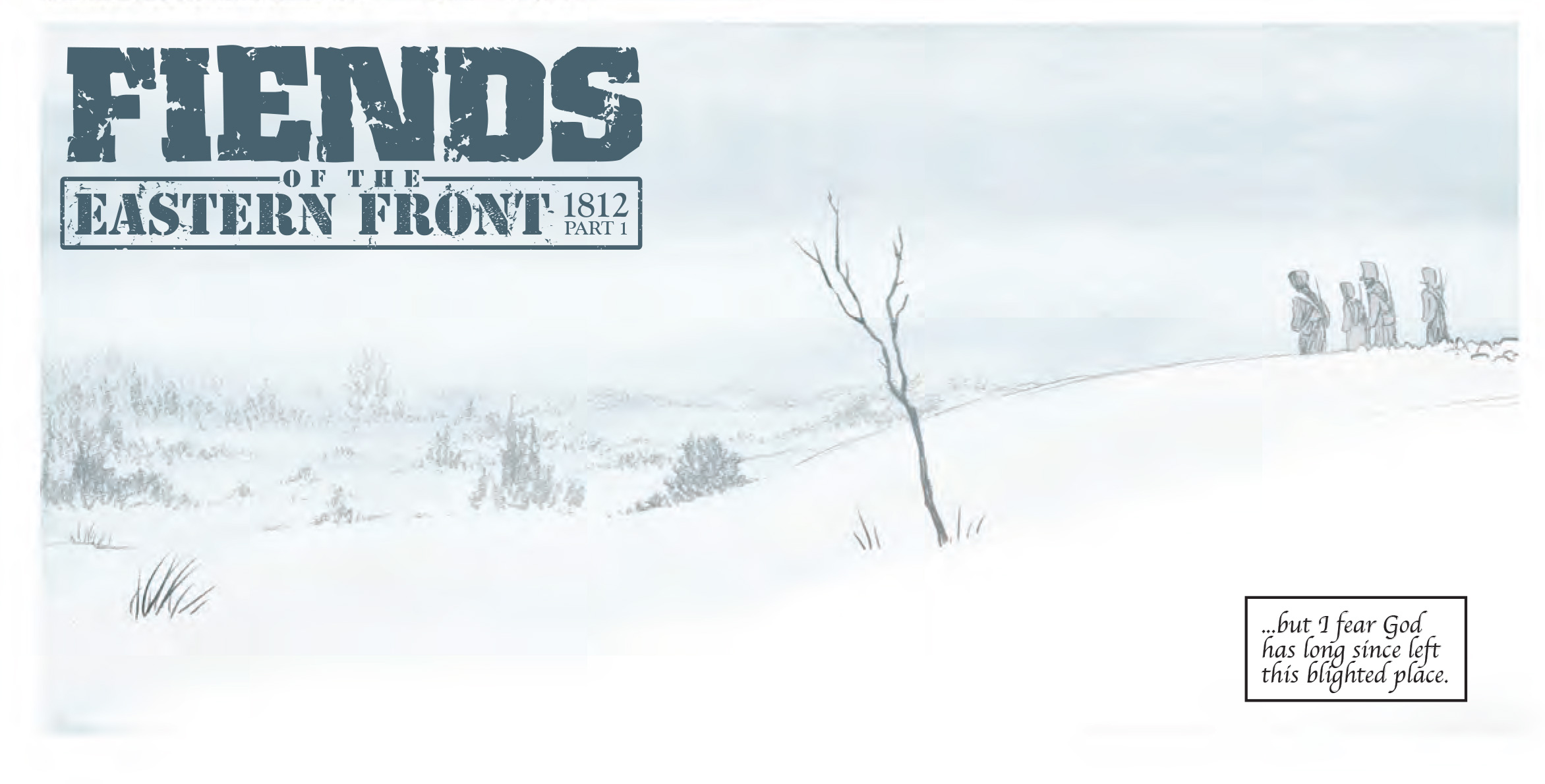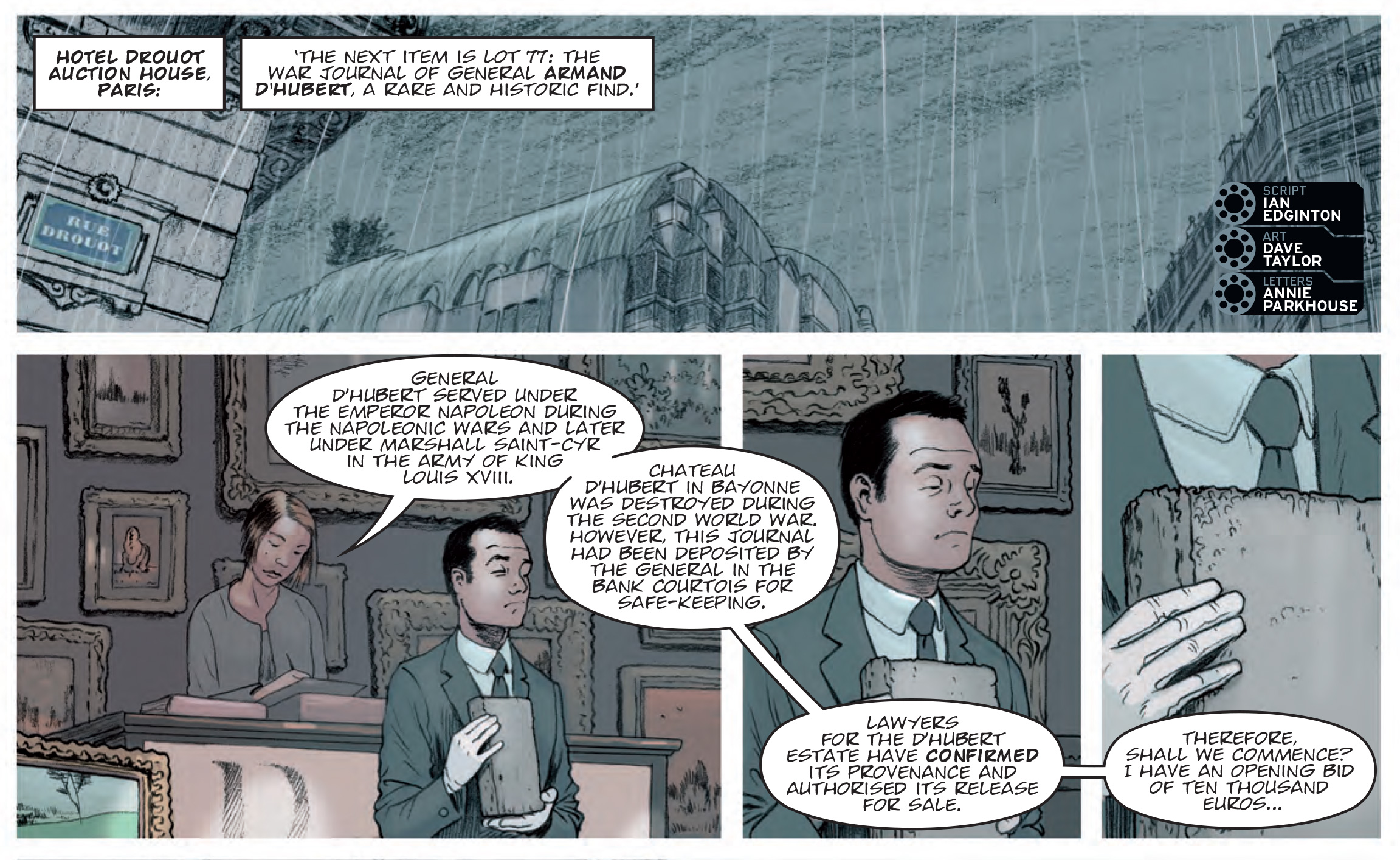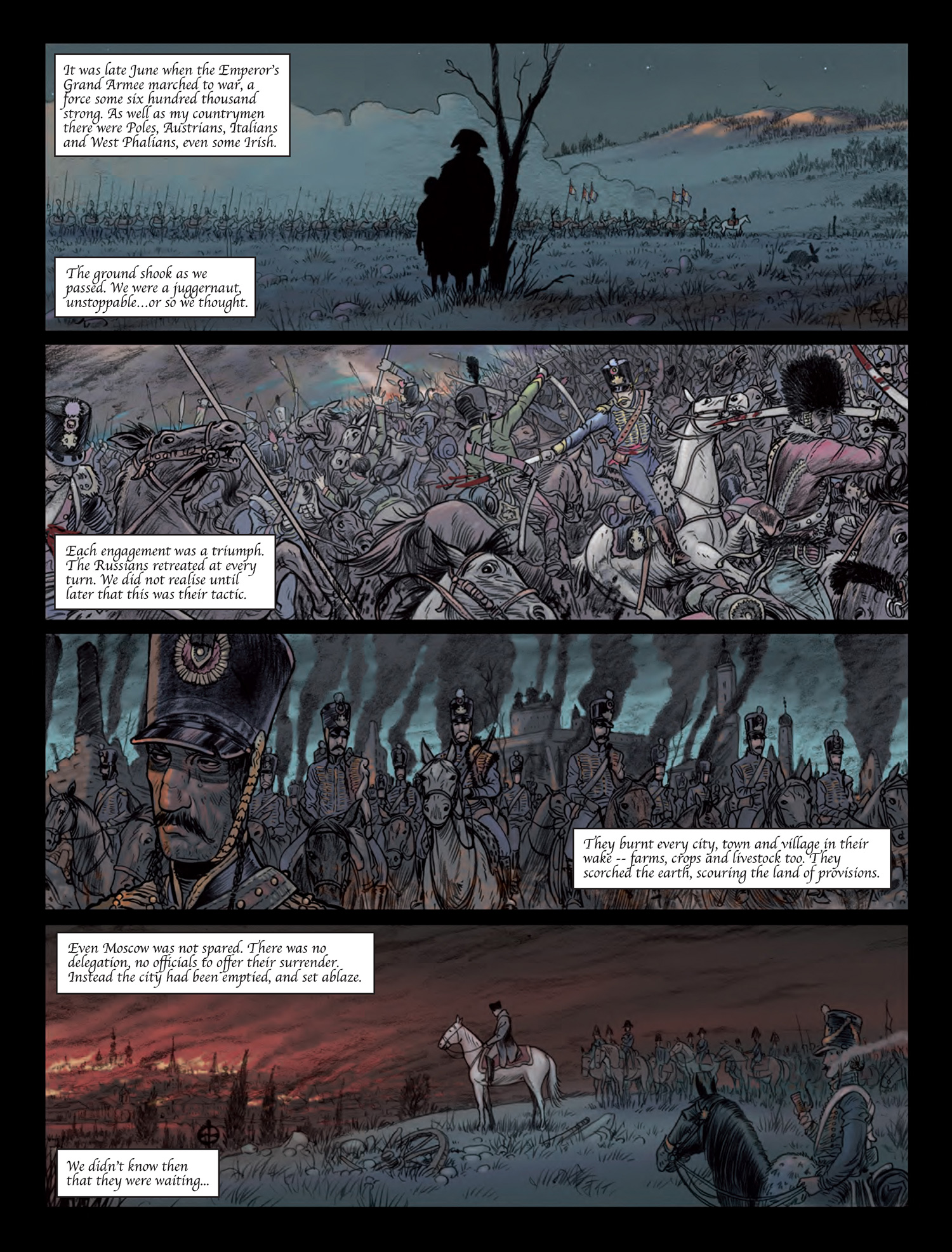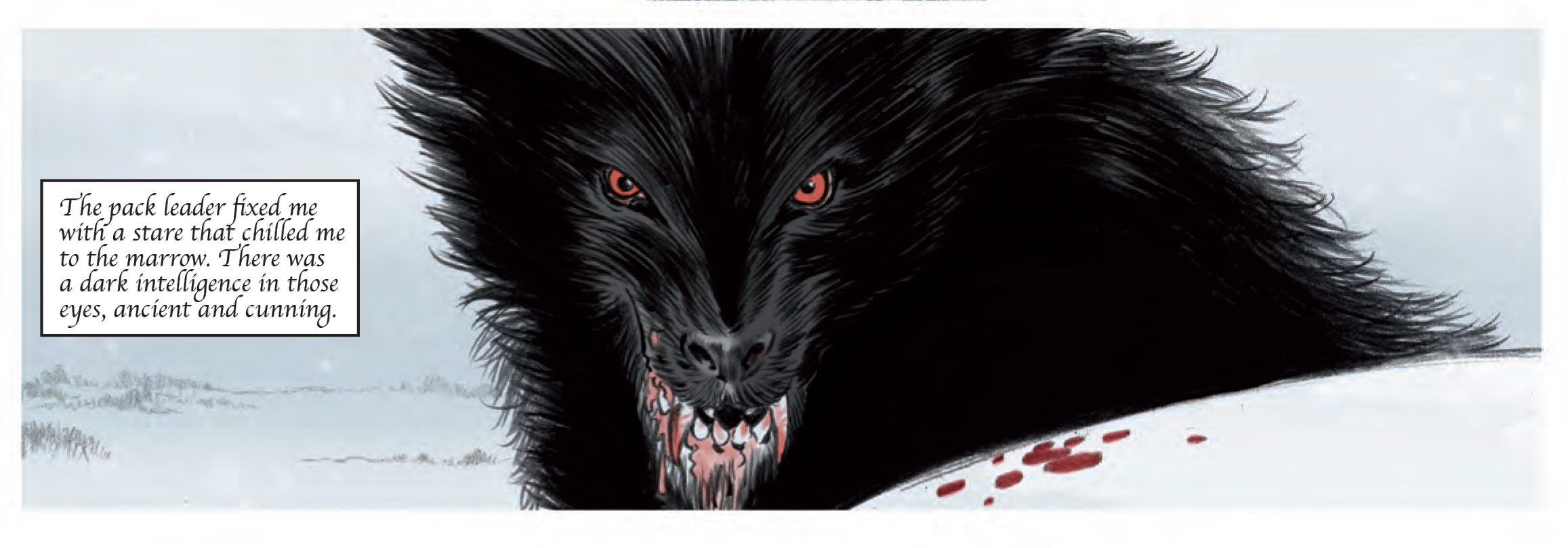INTERVIEW: Fiends of the Eastern Front with Ian Edginton and Dave Taylor
30th September 2018
Fiends of the Eastern Front was a blood-curdling tale of warfare with bite. It first appeared in Progs 152-161 in 1980 when creators Gerry Finlay-Day and Carlos Ezquerra told a tale of a mysterious squad of Romanian soldiers, fighting alongside the Germans in the chilling conditions of the Eastern Front. The full story is revealed in full through the diary of Hans Schmitt, telling the terrifying tale of Romanian Hauptmann Constanta and his squad of blood-sucking nightmare stormtroopers, who cut a bloody swathe through the enemy, no matter which side they were on.
Subsequent appearances from Constanta came in ‘Stalingrad’ by David Bishop and Colin MacNeil (Judge Dredd Megazine #245-252, 2006) and ‘Fodder’ by Hannah Berry and Dani K (2000 AD Free Comic Book Day 2016). There have even been crossovers, including a fleeting one with Judge Dredd (‘Helter Skelter’ by Garth Ennis, Carlos Ezquerra, and Henry Flint, 2000 AD #1250-1261, 2001) and Durham Red (The Scarlet Apocrypha: Red Menace by Dan Abnett and Carlos Ezquerra, Judge Dredd Megazine #4.17, 2002), proving that, through time and space, an immortal vampire has a habit of surviving no matter what.
But, in the very speacial 2000 AD Prog 2100 (on sale 26th September), we finally see the return of Constanta in Fiends of the Eastern Front: 1812. What new nightmares will this new tale of the horrors of war and the war of horrors reveal? Richard Bruton sat down with writer Ian Edginton and artist Dave Taylor for the answers.

Fiends of the Eastern Front is a strip with a reputation belying its few appearances. In a comic that was so futuristic, setting a strip back in time and mixing war story and classic horror seemed somewhat revolutionary. Do you remember it when it was first in 2000 AD back in 1980?
Ian Edginton: I do remember it quite vividly. It came out of left field for 2000 AD, which at the time had primarily established itself as a science fiction comic. Nevertheless, it still had that antiestablishment sensibility that characterised 2000 AD but also harkened back to the classic British war comics that I grew up reading – Valiant, Victor, Hotspur and Warlord. Vampires fighting during World War 2 seemed like such a cool idea and then there was the added twist that you were on the side of German soldier Hans Schmidt as he locked wits with Constanta and his men. Getting you to empathise with the enemy was very 2000 AD!
Dave Taylor: When Ian mentioned it I knew I’d read it but didn’t have a clear memory until I found some of Carlos’ illustrations and BAM! I was right back in my youth. I can’t say it had a huge impact on me, it was up against such fond favourites as Dredd and Strontium Dog, I’m a sci-fi nut you see, but it was so unusual, so twisted and typically weird that I would have lapped it up. I’d been a classic 70’s kid, fascinated by war, had a regiment of Action Men and assorted kit, so anything war related, though taking second place to science fiction, was warmly welcomed.
The original was set in WWII on the Eastern Front and brought a vampiric bite to war stories with Gerry Finlay-Day and Carlos Ezquera doing a fine job bringing us, as the cover to Prog 152 tells us, “Not the horror of war, the war of horrors”. What can you tell us about this new Fiends of the Eastern Front: 1812 and the return of Constanta?
IE: The war of 1812 was a perfect fit for the story. Napoleon’s Grande Armee rolled into Russia with an army of around 600,000 men. They weren’t just French but there were Poles, Austrians, Italians and even some Irish. They were an unstoppable juggernaut, or so they thought. Pretty much every encounter they had with the Russians they won, with the Russians retreating – but they didn’t count on Russian tenacity and bloody mindedness. The Russians burnt their own towns and villages, farms, crops and livestock, depriving the French of provisions. When he reached Moscow, Napoleon expected there to be a delegation to surrender the city to him. Instead no one turned up and they’d set parts of the city on fire. There weren’t rules of war as far as the Russians were concerned.
With the savage winter setting in, his men starving and demoralised, Napoleon’s men were in retreat and being harried by packs of Cossacks which is where we come in. Something supernatural is also hunting them. French officer Major D’Hubert is obliged to join a certain Romanian Captain Constanta and his men in tracking down and killing this predator. The Romanians had long been oppressed by the Russians so it was natural that they’d ally themselves with the French but of course Constanta has his own agenda. It’s already been established in the previous stories that there are vampires and golems around but Dave and I intend to reveal more of this supernatural world.
DT: The first thing you need to know is that this is possibly Ian’s best writing. He’s outdone himself. This reads like something Kubrick or Wells directed. It’s poetic, rich, filled with feel and craftsmanship. It’s proper literature!
The near immortal nature of Constanta certainly opens up the strip to a world of stories, with potential settings in both the past and the future. I know it might be too early to answer this, but, have you thought about yourselves continuing with Fiends in the future and, if so, where would you like to take Constanta?
DT: I can see Ian becoming very attached to Constanta. I can tell he’s having a lot of fun in this universe and so I can imagine he’ll want to do more, explore the character more deeply and see where it takes him…as long as it’s a front and it’s East of something.
IE: Funnily enough I’m writing another Fiends story at the moment that’s being drawn by Tiernen Trevallion. I can’t say too much as it features something of a cracking crossover but I think people are going to enjoy it! There are also stories covering Constanta’s back-story in the works. In the original Fiends story and the later ‘Stalingrad’, Constanta was going to great pains to conceal knowledge of his presence. I want to know why? Who or what is he trying to hide from? We’ll delve into that, his former human life and how or why he became a vampire?
Dave, thus far, Fiends of the Eastern Front has had a spectacular artistic pedigree, with first Carlos Ezquerra and then Colin MacNeil adorning the pages. How did you approach the strip artistically, given that the two styles thus far are both different from each other and so distinctive?
DT: I always take each job as a new task and never read it with an artistic style in mind. It’s not until I’ve soaked up the script that I start thinking about the best way to tell the story visually. I never get hung up on what’s gone before…well, I did on Batman…and, yeah, I did on Dredd…but maybe I’m more comfortable in my skin these days! The style I’ve gone with makes sense to me and both Ian and the mighty Tharg are very happy with it, so hopefully the readers will agree. I’ve done a few jobs in pencil, without ink, and this story cried out to be textural and gritty so a pencil style was ideal for it.
With your style, we’ve talked before about it being a very European style, with obvious influences from Moebius, amongst others. It’s also a very distinctive style in the pages of 2000 AD. Have you made any changes to your art for this new Fiends series?
DT: I don’t think this is like anything I’ve done on Dredd or Anderson, that’s my Mega-City style and that alone. It’s a totally different approach, from the design stage to the finished page on this. It’s always the story that is the most important aspect, not the ego of the artist, and so I didn’t think “This’ll have to look like my Dredd stuff or folk might not like me any more!”
IE: Dave has brought a very strong look to this series. I know he’s often thought of as being mainly a science fiction artist but his artwork on this series is amazing. I thought that he’d hate me for all the historical reference I loaded him with, not to mention all the horses he’s had to draw but in all honesty, I think this is some of his best work to date. People are going to love the way it looks.
Ian and Dave, you last worked together on the Judge Lamia story in Judge Dredd, only her second appearance, but one that really resonated with readers. Any news on when you’ll be returning to this fascinating MC-1 character?
IE: There’s definitely more Judge Lamia stories to come. Now we’ve teamed her up with the ghost of Judge Lola the first thing they’ll do is try to find out more about how she came to be a ‘death herder.’ They’ll be plenty of off-world hijinks and horror!
DT: I’d love to get something out next year, which is entirely possible.
The results look fantastic, so how does your creative process and the relationship between writer and artist work for you?
IE: The process is pretty seamless. We get on well with each other so there aren’t any problems. Occasionally Dave will suggest a better layout for a page so I’ll tweak the panels or dialogue accordingly.
DT: The only difference was the reference sourcing for life in 1812. Ian included some references in his script, which was very helpful and gave me a good idea of how to fill out the other reference needed. Other than that it’s exactly the same: both of us in a cave dressed as ladies smoking the finest cigars and supping Absinthe. Same old.
Finally chaps, what can we look forward to from you both in the future?
DT: We’ve talked a lot about future projects and have a few plans firming but nothing I can talk about, outside of our Cave Ladies series, obviously.
IE: There’s more Kingmaker, Scarlet Traces and Brass Sun coming up for 2000 AD as well as a second Iron Maiden: Legacy of the Beast series for Heavy Metal.



